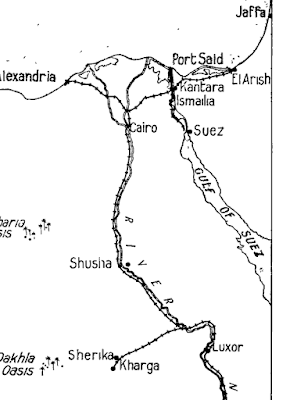I thought it might be interesting to provide a little
background about the 1st Squadron, Australian Flying Corps.
You will have
noticed that Athol’s letter (15 July 1916) was stamped with “'A' Flight 1st Squadron
A.F.C.” The
Squadron was formed at Point Cook outside Melbourne,
Victoria, in January 1916. Only a few weeks later, on 16 March 1916, the unit
sailed from Melbourne. A total of 28 officers and 195 other ranks arrived in Egypt on 14 April and, shortly after their
arrival, the less experienced pilots went on to England for further training.
The remaining airmen stayed in Egypt as part of the British
Expeditionary Force. This modest Australian unit was dovetailed into the British Flying Corps and under
its command. As part of this process the 1st
Squadron, AFC was re-named No.67 (Australian) Squadron R.F.C.
However, the unit itself never regarded itself as part of the RFC, and never
used its official RFC number. There was no consultation with the new Australian Flying Corps personnel about this change and the men strongly resented the implication that the Squadron was a unit subsumed into the British RFC. Richard Williams, a flight commander of 1st Squadron AFC, put it this way in his autobiography: 'There was no more authority for calling us a squadron of the Royal Flying Corps than there was, for example, for calling the 9th Battalion AIF, the 23rd Battalion of the Middlsex Regiment.' Hence Athol’s letterhead with ‘A’ Flight 1st
Squadron A.F.C. In February 1917 the General Officer Commanding, Royal Flying Corps, issued an order giving effect to the wishes of the Australians and the Australian Squadrons thereafter retained their original Australian names.
In 1916, the Australian Flying Squadron was
comprised of 3 Flights - A, B and C. Athol was in ‘A’ Flight. To start with, each
Flight only had 4 planes. The Squadron also brought with it from Melbourne other
transport equipment which amounted to 2 motorcars and 7 'motor-bicycles' which
were all the property of the airmen themselves. This small crew formed the beginning
of the Royal Australian Air Force (RAAF) and was soon on active duty.
Major T.F. Rutledge*, an Australian from the Western districts of Victoria, arrived from England to
command the Squadron. We know from his 15 July letter that Athol reported to
Major Rutledge the day before being sent to Sherika to join ‘A’ Flight in mid-July 1916. One interesting aside is that the CO of 1st Squadron
AFC, Major Rutledge, had no previous experience of Army administration and did
not produce a War Unit Diary. Therefore there is no official record of from
April 1916 til December 1917. This is noted in Clifford's book - reference below.
In mid June the the Australian Squadron took
over the machines of the 17 Squadron RFC which had been sent to Salonica. The
Australians also took over the 17th’s Canal stations and
headquarters at Heliopolis. The Australians’ ‘B’ Squadron was the first to be
sent out on active duty to the Suez station. ‘C’ Flight remained at Squadron Headquarters
at Heliopolis. Captain Sheldon and ‘A’ Flight were sent to Upper Egypt and the
base at Sherika within the Kharga Oasis on 9 July 1916.
‘A’ Flight stayed at Sherika until 8 November
1916. The reconnaissance flights from Sherika flew over hundreds of miles of
desert much of which was occupied by the Senussi. The AFC's mission was to find the enemy and report
their location and strength so that the BEF ground forces could pursue them.
The BEF (British Expeditionary Force) in the Kharga Oasis was a composite force. They
were known as the Kharga Oasis Detachment under the command of Lieut. Colonel Angus MacNeil, 2nd
L.S. Yeomanry. Apart from the Yeomanry, the other sections under his command were the Highland Mounted Brigade,
a squadron of Egyptian Lancers, a company of the ICC, a
company of Royal Engineers, a battery of Sikh Mountain Gunners, an Australian Flying
Corps unit (1st Australian Flying Corps, 'A' Flight), 1,000 baggage Camels and 2,000
Egyptian Light Cavalry. There was also a bakery section and a slaughter-house and later another ICC
company were added. At their disposal were three 15-pounder guns.
Reference: Cutlack,
Frederic Morley (1941)
The Australian Flying Corps in the Western and Eastern
Theatres of War, 1914–1918. Official History of Australia
in the War of 1914–1918. Volume VIII (11th ed.). Canberra: Australian War
Memorial
D.D. Ogivy's book 'Fighting on Three Fronts: A Black Watch Battalion in the Great War' is also a useful reference.






